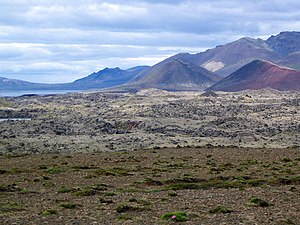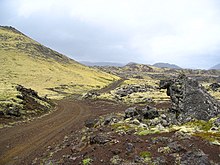Berserkjahraun
| Berserkjahraun | ||
|---|---|---|
|
Berserkjahraun in summer |
||
| height | 379 m | |
| location | Iceland | |
| Mountains | Ljósufjöll | |
| Coordinates | 64 ° 57 '47 " N , 22 ° 58' 16" W | |
|
|
||
| Type | Rows of craters and lava field | |
| Age of the rock | about 4000 years | |
| Last eruption | around 2000 BC Chr. | |
|
Berserkjahraun from the west |
||
The Berserkjahraun lava field, interspersed with rows of craters, is located in the west of Iceland . It belongs to the Ljósufjöll volcanic system and is located in the north of the Snæfellsnes peninsula near Stykkishólmur .
Surname
The lava field takes its name from events that are described in one of the Icelandic sagas, the Eyrbyggja saga (13th century). They are probably also mentioned in an older source, the Heiðarvíga Saga , but the original has not been preserved.
Accordingly, the Viking Vermóður came into the lava field with two brothers who were berserkers from Sweden . After a while the wild guys grew over his head and he gladly passed them on to his brother Víga-Styrr . After a while he also had his problems with the strong and unruly men. Halli , one of the brothers even wanted Ásdís , his master's daughter, to be a wife. Víga-Styrr apparently initially gave in, but made one condition: The berserker should build a path through the lava to Bjarnarhöfn and also build a small fortification in the lavas. The two berserkers succeeded. But Víga-Styrr didn't stick to the deal and instead had the two killed and buried in the Berserkjahraun.
You can actually still find a clearly recognizable path that dates back to the Middle Ages and leads through the lava field to Bjarnarhöfn, and on it both a small fortification and the grave of two men. Archaeologists excavated bones there.
On the geology of the lava field
The neo-volcanism on Snæfellsnes - it started again two million years ago after a pause of about five million years ago - are highly alkaline ejecta rocks. This applies to all three active volcanic systems on Snæfellsnes : Snæfellsjökull , Lýsuskarð and Ljósufjöll .
This also applies to the Berserkjahraun lava field, which was created around 4000 years ago. The lavas emerged from a series of craters consisting of four craters of the Ljósufjöll volcanic system. You are between Kerlingarskarð and Seljafell . In the east lies Rauðakúla (379 m), then Gráakúla (211 m), Smáhraunakúla and in the west Kothraunskúla (191 m). The eruption started in Kothraunskúla. Then followed the craters Rauðakúla and Gráakúla and finally the smallest crater Smáhraunakúla. It covers a large part of the west of the municipality of Helgafellssveit . The lavas have poured into the sea on both sides of Bjarnarhafnarfjall mountain .
Two lakes formed in the eruption when the lavas dammed streams: Selvallavatn and Kothraunsvatn . Both lakes have only underground drains.
These are mostly difficult to cross Aa lavas made of alkali olivin basalt .
The lava field is now under nature protection .



